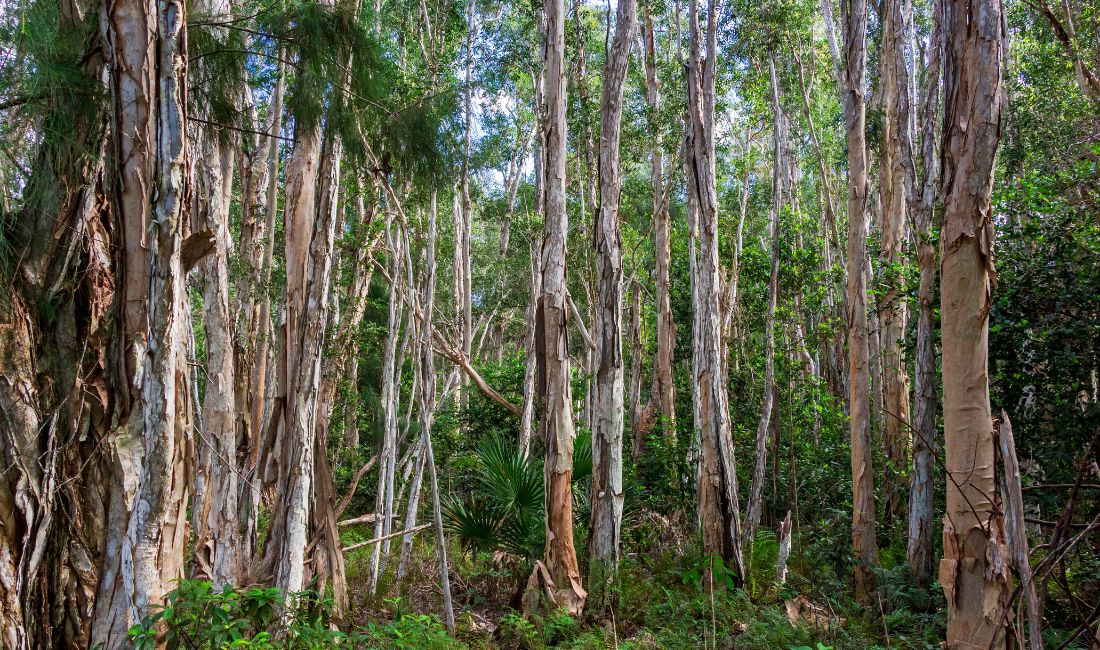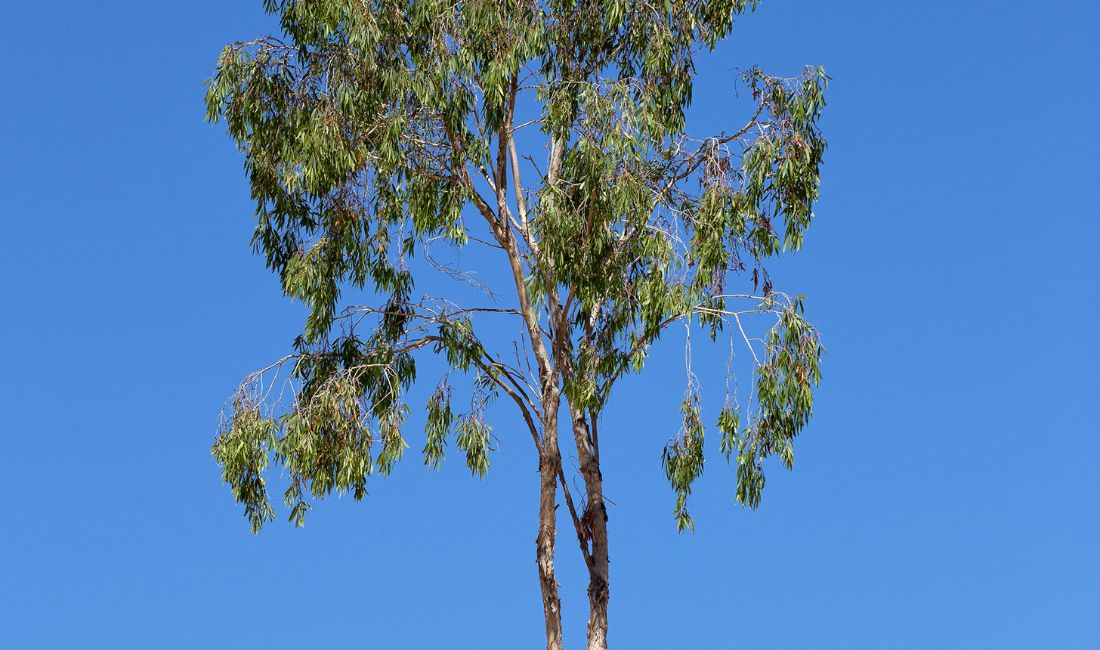Melaleuca (Melaleuca quinquenervia) is an invasive tree (or weed) in Palm Beach and is damaging our local ecosystem.
Native to Australia and other areas of the South Pacific, Melaleuca is banned by the state, federal, and regional agencies in the United States due to its propensity to displace native plants and trees.
In this article, we’ll go over how to recognize if you have this invasive tree on your property, some issues with this tree, how to remove it, and more.

How to Recognize Melaleuca
Melaleuca goes by many names, including punk tree, paperbark tree, and cajeput.
These trees are most easily recognized by their thickly layered bark, which is white, brown, orange, and/or tan and is often peeling off in sections. Another way to recognize melaleuca trees is by their tall size – they sometimes grow 80 to 100 feet, and there are usually many trees together, forming a thicket.
Melaleuca trees are evergreen, keeping their foliage year-round, and they produce white flowers that resemble a bottle brush, and seed capsules that can contain up to 300 seeds. Flowers and seeds are produced year-round, which is one of the reasons why some melaleuca trees can produce 20 million seeds per year.
The leaves are grayish-green and lance-shaped, 2 to 5 inches long and filled with oil, making the leaves feel leathery.
Melaleuca trees grow close together, forming dense stands that prohibit any native plant or tree from growing.

Why are Melaleuca Trees Problematic?
Melaleuca Trees Grow Rapidly, Reproduce Rapidly, and Force Out Native Vegetation
As with any invasive plant, melaleuca trees are preventing the growth of native species and are instead multiplying and growing rapidly, taking over much of South Florida and the Everglades.
According to the University of Florida, “Since its introduction from Australia a century ago, melaleuca has infested more than half a million acres of natural areas in the greater Everglades region. Melaleuca trees produce millions of seeds, are adapted to fire, grow quickly and invade a wide range of native habitats. They form dense forests that crowd out other vegetation, interfere with water flow and alter ecosystems.”
Invasive species do little to benefit our native wildlife. Additionally, since they have no native predator, the trees can grow and reproduce without limit. A study found that native melaleuca trees in Australia produced fewer seeds overall (5,000 vs. 13,000) and fewer viable seeds (<200 vs. >1,200) than melaleuca trees growing in the United States.
Fire Doesn’t Kill Melaleuca Trees
Natural events that might kill or destroy other trees can benefit melaleuca trees. For instance, fire. Fire destroys many trees, but fire aids melaleuca trees in spreading. In fact, the name Melaleuca comes from the Greek words melas (black) and leukos (white), in reference to black sections on the white trunks from fire burn marks.
Most South Florida wildfires now involve melaleuca trees. Where before, most South Florida wildfires were in grasslands and impacted low-growing bushes, the thin bark of the melaleuca brings the fire up the tree canopy. The tree is not harmed by the flames, and in fact, the flames can force the seed pods open, leading to seed dispersal and many seedlings that grow in the area cleared of natural grasses and plants due to the fire.
Melaleuca leaves contain oil, which can increase the fire’s intensity, leading to further destruction of nearby plant life and structures. After a wildfire, melaleuca trees are left standing and ready to reproduce, while most other plant life has been killed.
Melaleuca Trees Turn Marshes into Swamps
While this is more problematic in the Everglades than in Palm Beach, it is still true. Marshes are made up of grasses and herbaceous plants such as reeds, cattails, etc. Swamps are made up of trees and woody plants. The melaleuca trees are taking over marshes and, again, forcing out native marsh plant life.
Melaleuca Trees are Highly Allergenic
The year-round blooms can cause allergy symptoms for many people. The flowers have a strong scent and can release oils that “can cause allergy-like symptoms such as headaches, respiratory problems, and skin rashes,” according to the University of Florida.
The bark can also cause a skin rash, and the flowers can cause nausea in some individuals.
Melaleuca Trees Drop Branches Frequently
Melaleuca trees are quite messy. The seed pods and seed pods fall everywhere, new seedlings constantly pop up, the bark peels in layers, and the tree will often “self-prune” by dropping lower branches at random. This last issue can be problematic if anyone is under the tree when this happens! The falling branches can also damage vehicles and buildings.
The tree drops more branches during times of flooding or drought. It helps the remaining branches and leaves survive, and often seeds drop with the branches, allowing the tree to ensure its offspring have a better chance of survival.
Melaleuca Trees are Prohibited
As mentioned earlier, both local and national organizations are working to remove this tree from Florida and other states.
It is listed as a Noxious Weed by the USDA under the Plant Protection Act, making it illegal to import or transport this tree within the U.S.
The U.S. Department of Agriculture mentions Melaleuca as an Aquatic Invasive on the National Invasive Species website.
Melaleuca is on the Florida Noxious Weeds list, and is also considered a noxious weed in Massachusetts, South Carolina, and Texas.
Melaleuca is one of several invasives required to be removed from any property in Palm Beach County.

Are there any positives to the Melaleuca?
In their native growing areas, melaleuca trees are beneficial to the local ecosystem. They are native in most of the South Pacific, including the east coast of Australia. There are animals that benefit from this tree there, and the trees do not grow out of control.
Plants and trees that are invasive in the United States can still be beneficial in the areas where they are naturally grown and cultivated.
One other benefit to melaleuca is that the wood can be used for mulch. Melaleuca mulch is highly sought-after because the oil in it can repel termites. It also decomposes at a slower rate than other types of mulch, which means it needs to be replenished less often. If you plan to turn a removed melaleuca tree into mulch, however, use caution as any seeds amongst the mulch can sprout into a new tree.

What to do if you Find a Melaleuca on Your Palm Beach Property
Melaleuca trees should be removed immediately. They are dangerous and invasive and can quickly take over your property, stealing nutrients, sunlight, and space from other plants and trees.
If there’s a melaleuca on your property, chances are high that there are also a lot of seeds, branches, and maybe even small saplings around the tree. Remove and dispose of all seeds and pull any saplings to prevent them from growing any larger.
We recommend planting native plants and trees on your Palm Beach property whenever possible. A good native alternative to the melaleuca tree is a bottlebrush tree. The flowers are very similar to the Melaleuca’s, but are red instead of white.
As part of Coastal Gardens Professionals’ Estate Landscape Services, our team is always on the lookout for any invasive or destructive tree or plant. Rest assured that if something unknown starts growing on your property (such as a melaleuca tree sapling that has sprouted from a rogue seed), it will be taken care of quickly.
Contact Coastal Gardens if you have questions about this or any other service that we offer for properties in Palm Beach.
CALL US TODAY At 561-308-7604
Estate landscape Services
For Fine Properties in Palm Beach
With Coastal Gardens, you can rest easy knowing that your property is taken care of by a dedicated team of estate landscape professionals who truly care about creating and maintaining a dazzling outdoor space you can be proud of.
